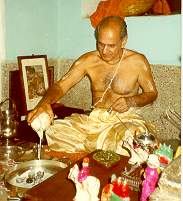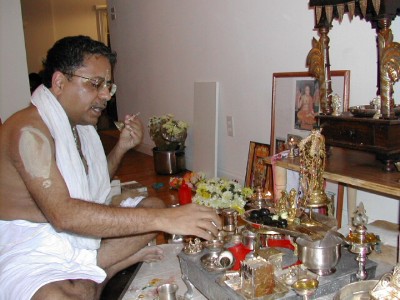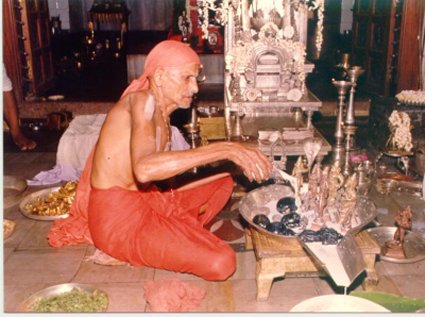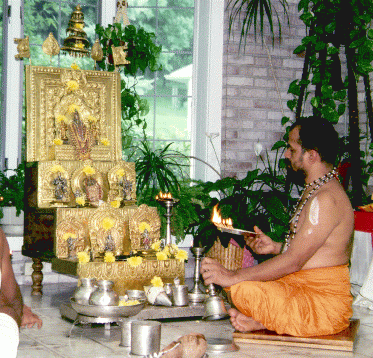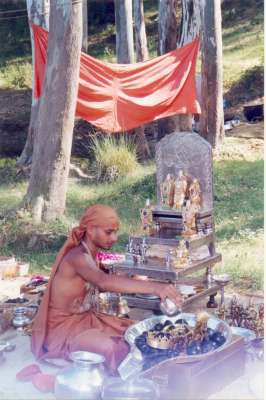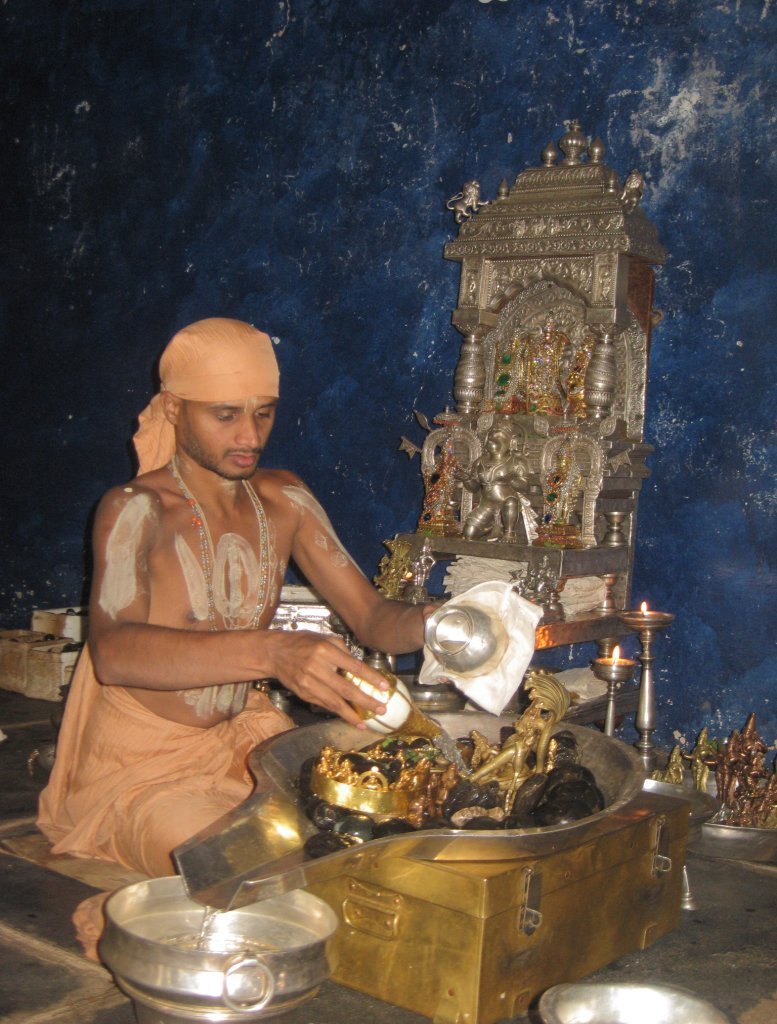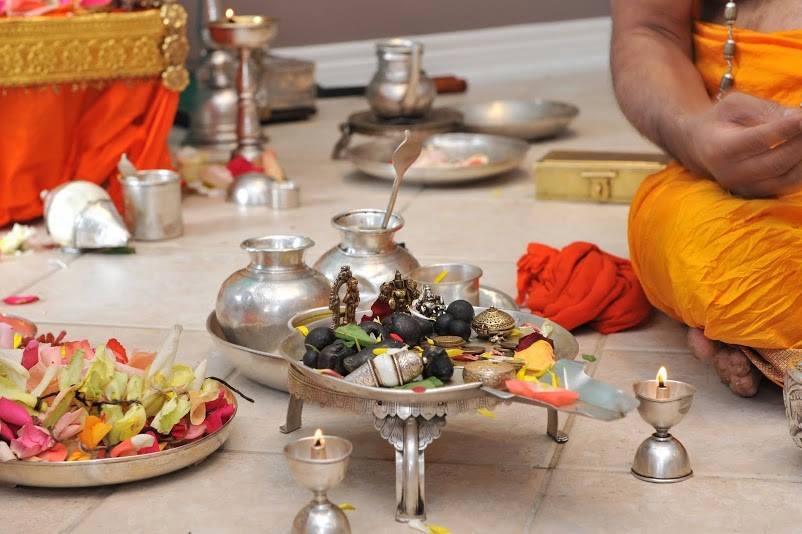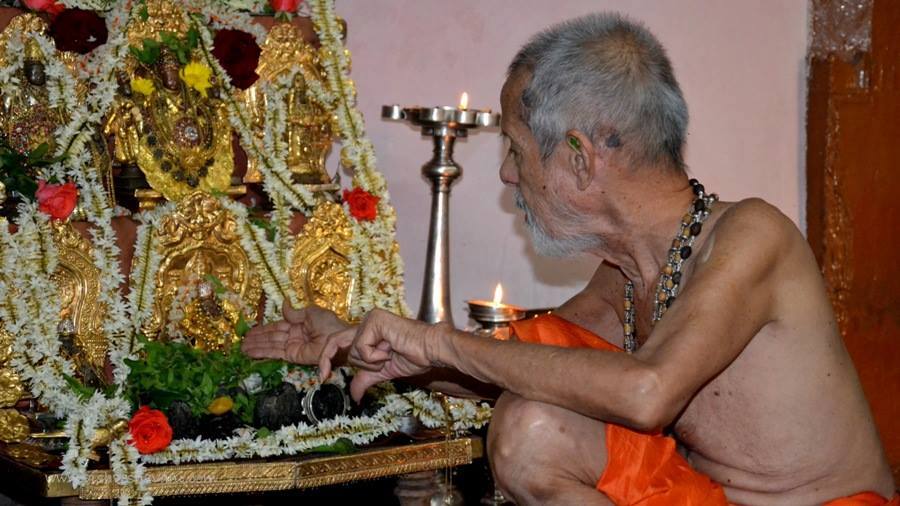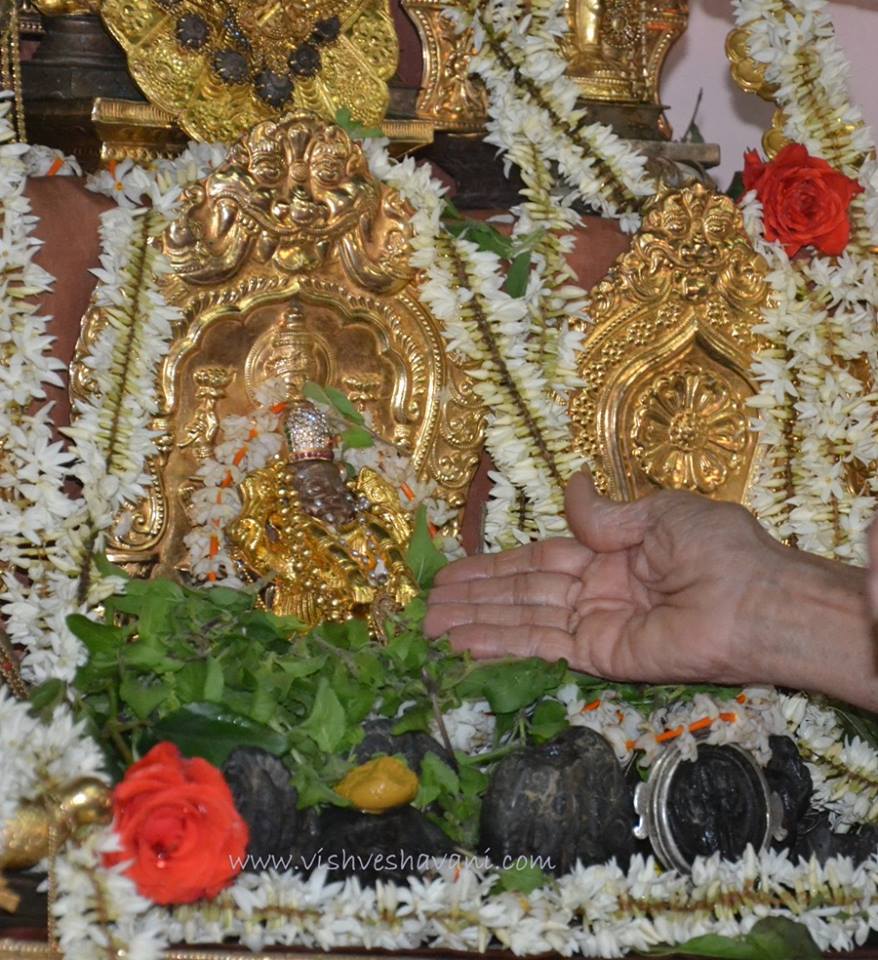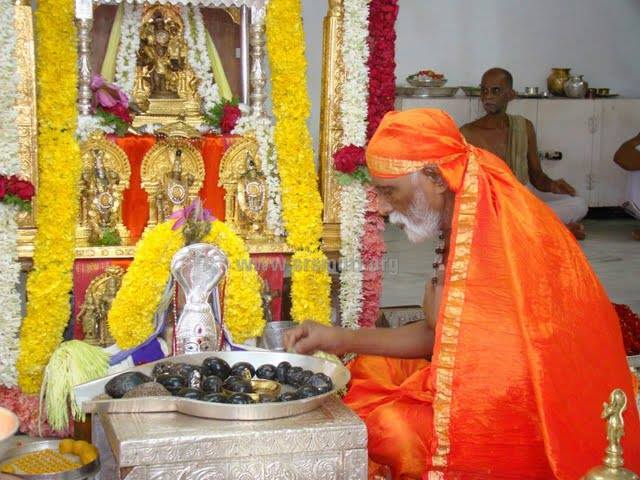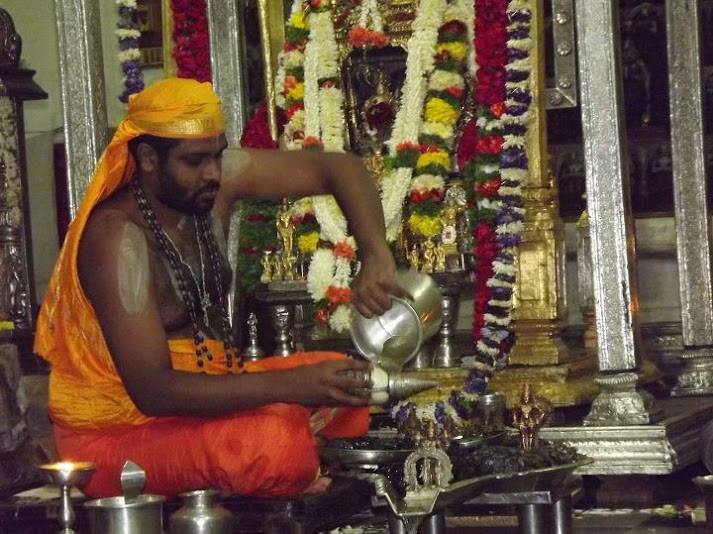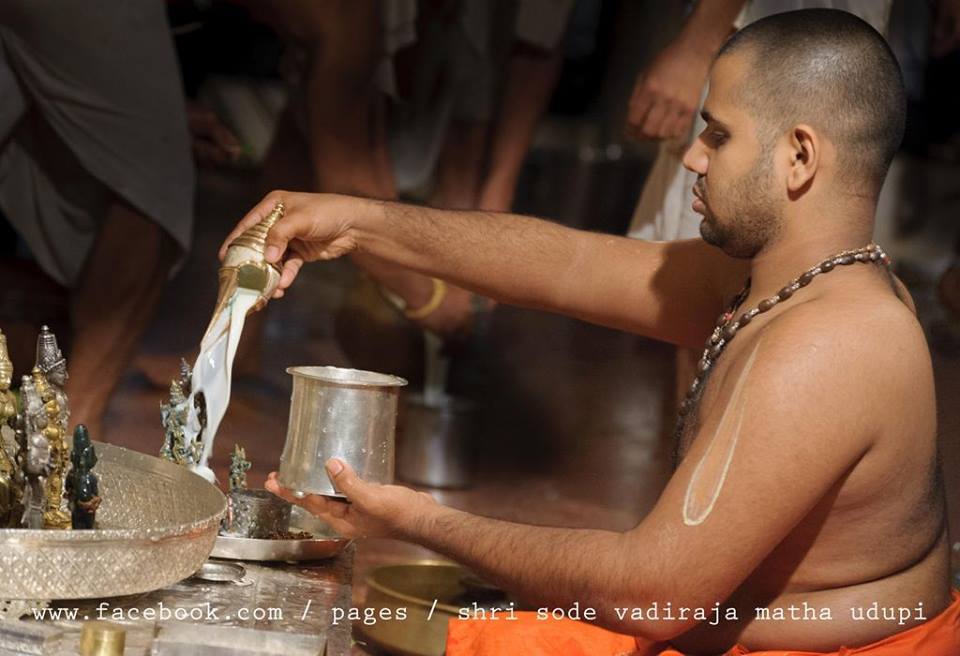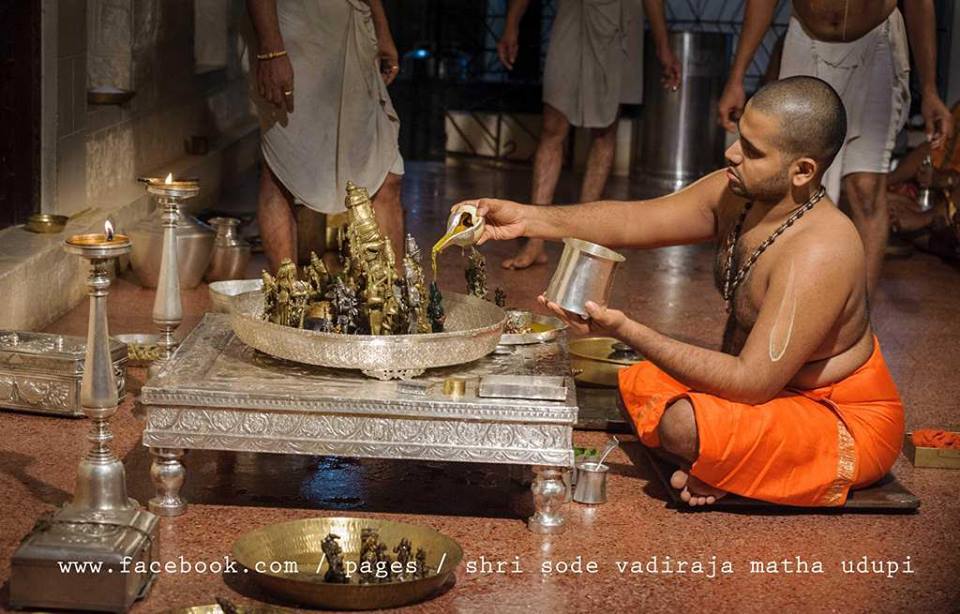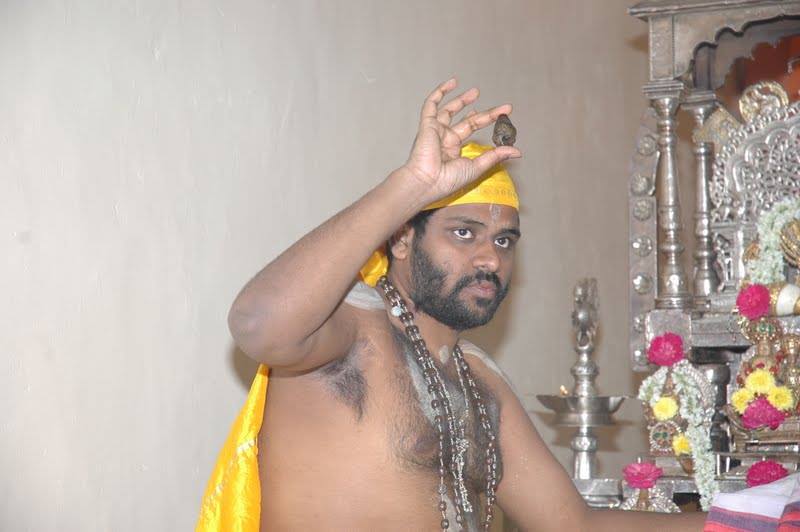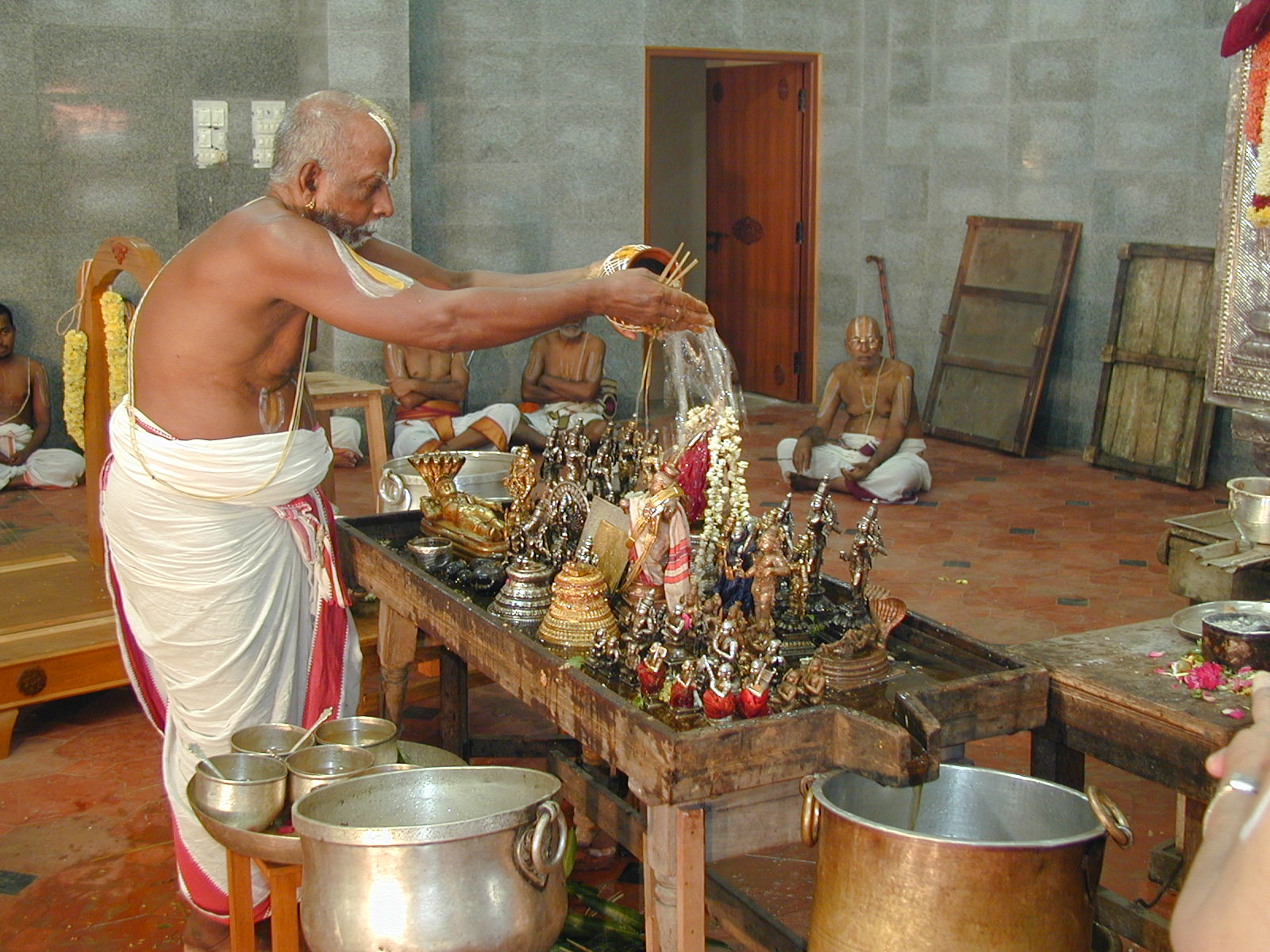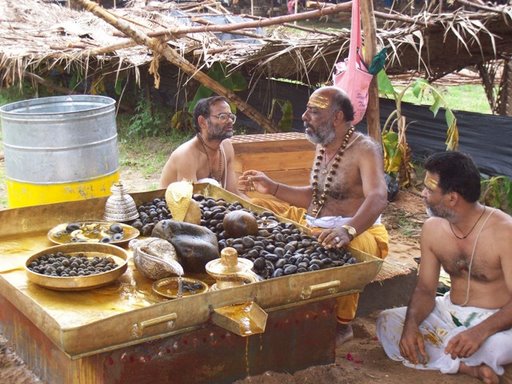
Poojya Sri V V Sridhar Guruji http://picasaweb.google.com/jwalas/KurmaNarayana
http://www.jwala.org/photogallery.htm

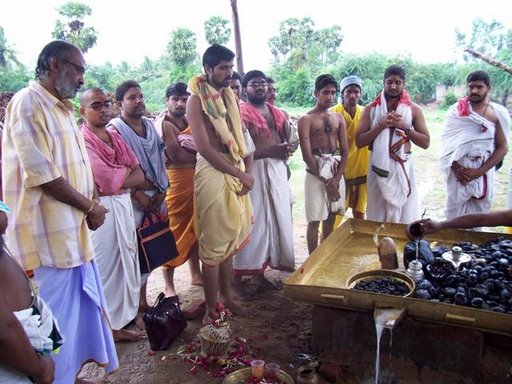
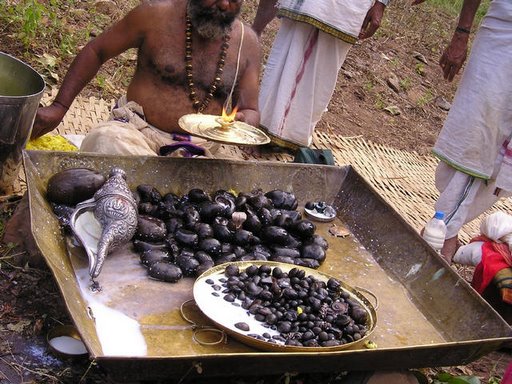
Poojya Sri V V Sridhar Guruji with his silas at Ahobilam-2003 he is
a Srivaishnava of the Vadagalai persuasion
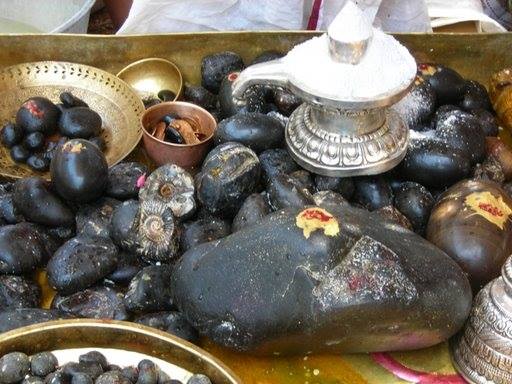
Here below we see much the same style of seva being
performed by some Iskcon devotees:
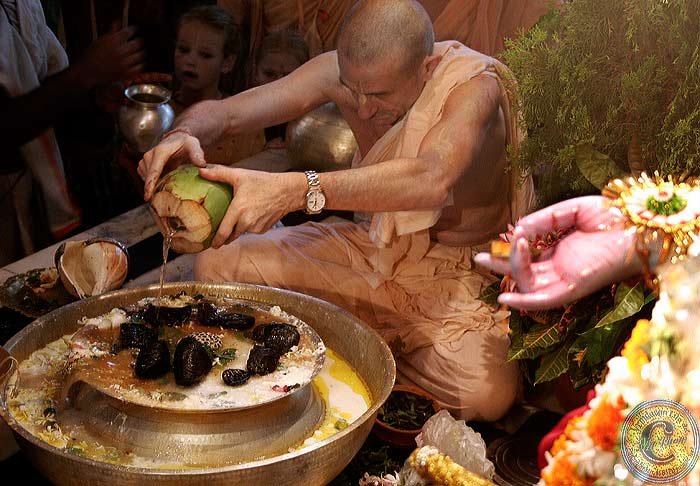
Jananirvas prabhu ACBSP bathing the Silas in public using among
other items a coconut daab
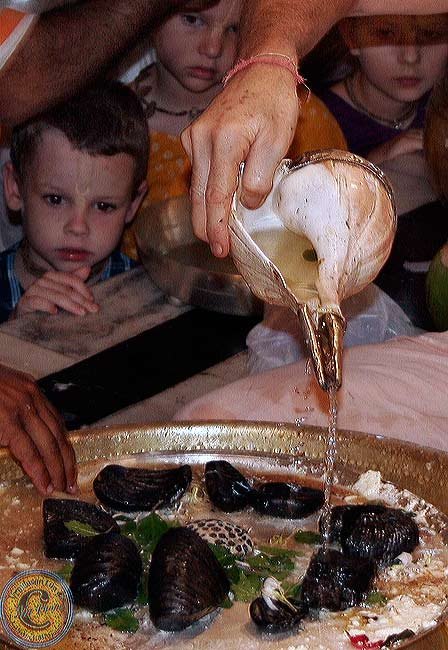
see the intensity of the children's watching the bathing............
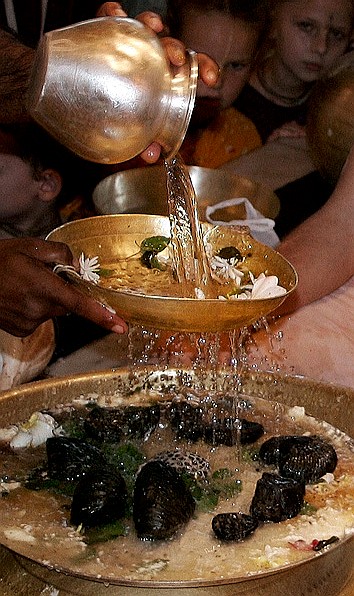
bathing with a sahasra dharu shower
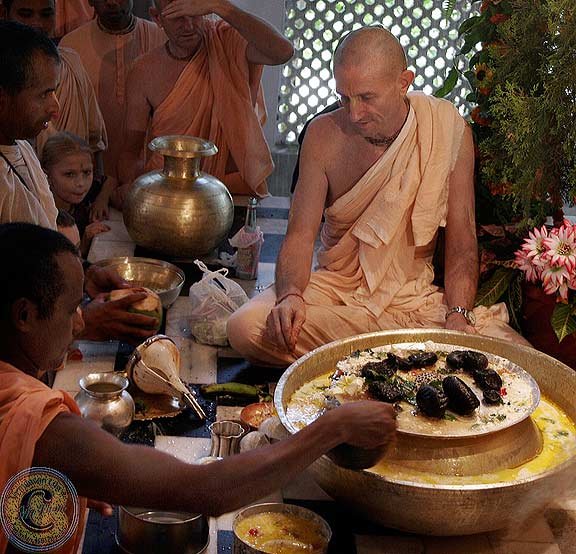
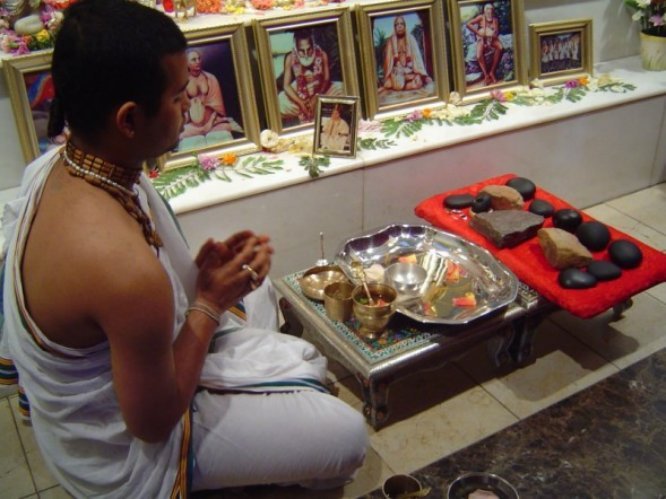
Akinchana Nitai dasa preparing
for abhisekha
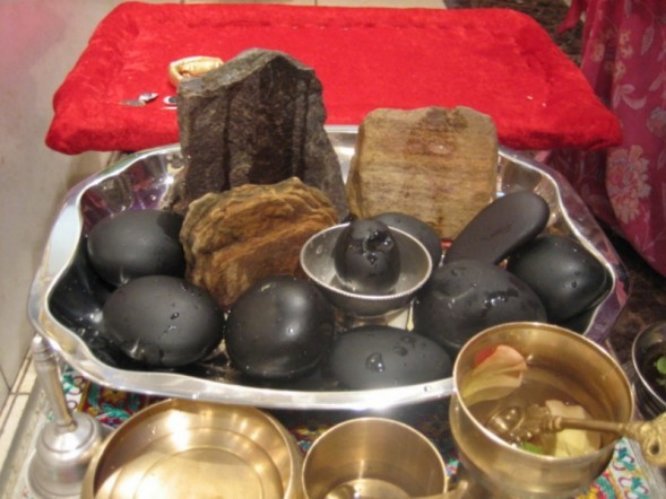
with his Silas sitting in the bathing tray
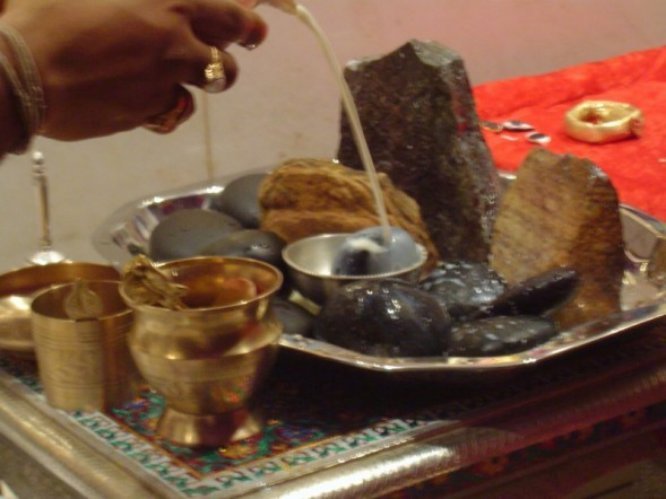
bathing Nrisingha shila
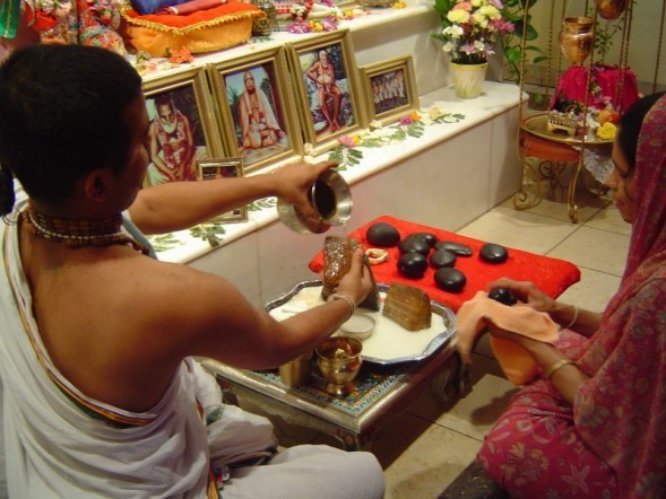
drying ready to place back on the altar
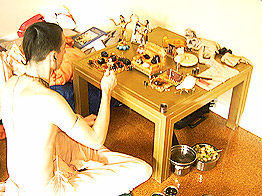
Matsya Avatara prabhu in Sydney
Australia.
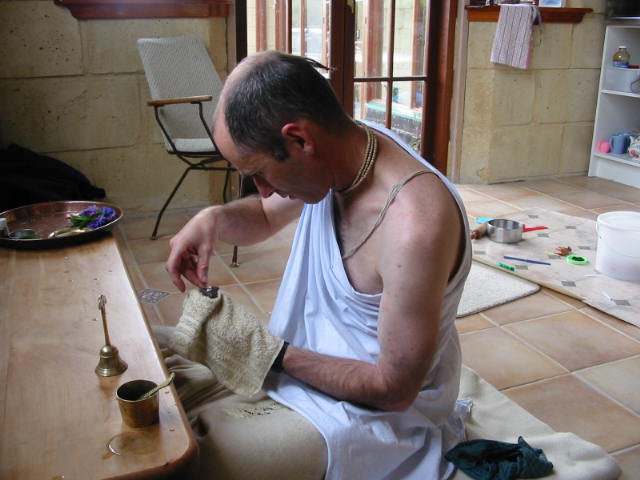
Trivikrama dasa drying his Govardhan
Sila during the puja at home
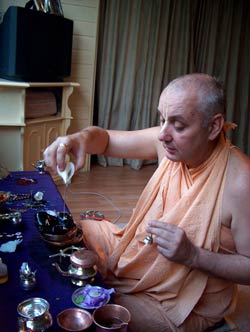
His Holiness (the late) Suhotra Tapa Gauravanacharin
(Suhotra swami) doing the seva puja for his Silas whilst travelling
here's a link to Suhotra maharaj's detailed seva pujan
http://www.suhotraswami.net/texts/puja.php
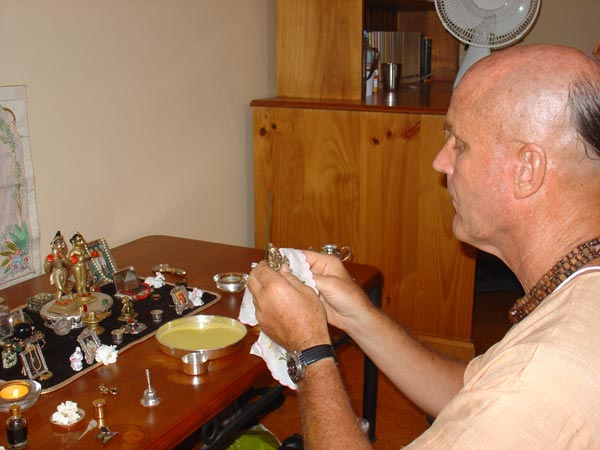
His Holiness Indradyumna Swami 2005
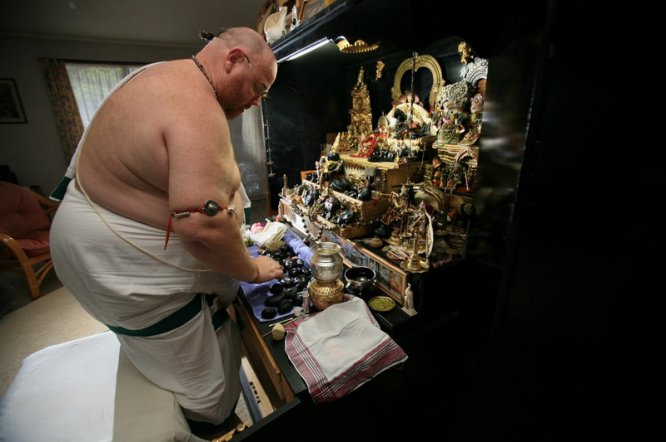
Jaya Tirtha Charan dasa at his altar April
2006 - photo by Bhakta Andre Wagner
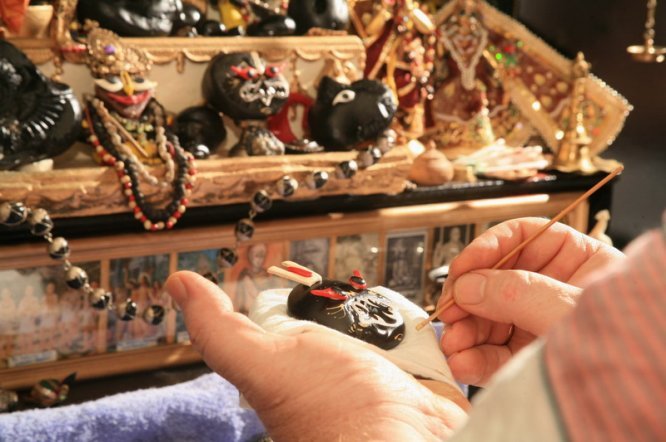
Jaya Tirtha Charan dasa putting tilak on
Pavana Nrsimha - photo by Bhakta Andre Wagner

Baladev Vidyabhushana prabhu
performing his puja
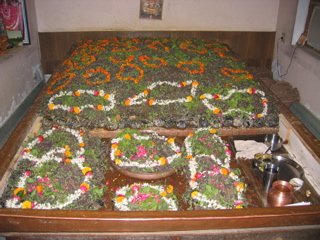
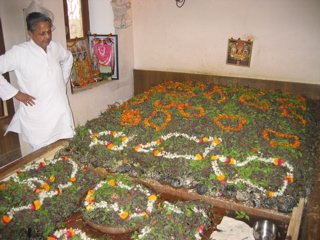


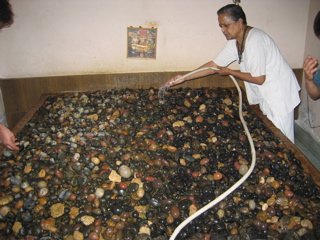
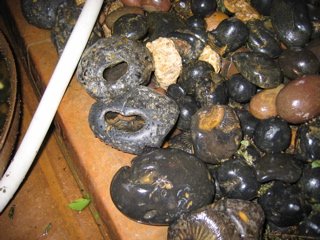

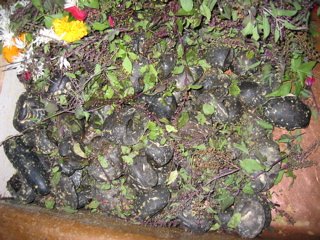
Hari Prasad Kemka in Benares
(Varanasi) serving the 65,000 silas in his care.
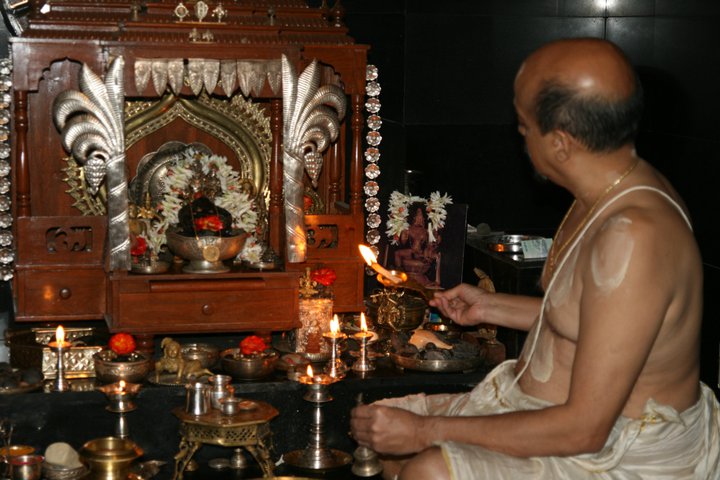
Sri Vidyabhushana in his early morning puja to his beloved Lakshmi Narasimha!!!
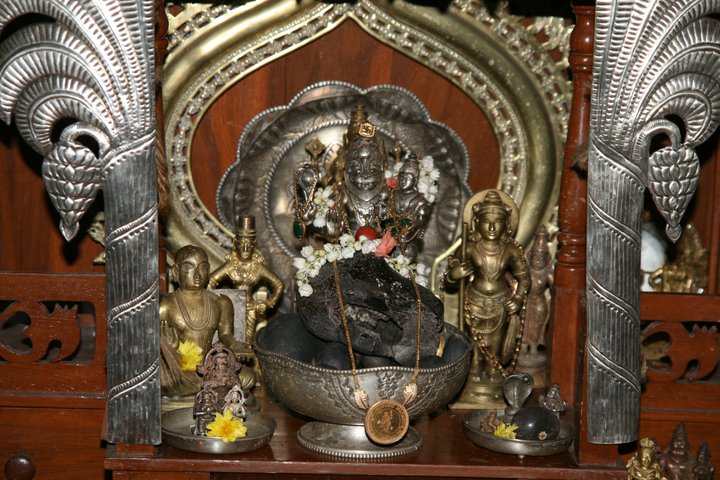
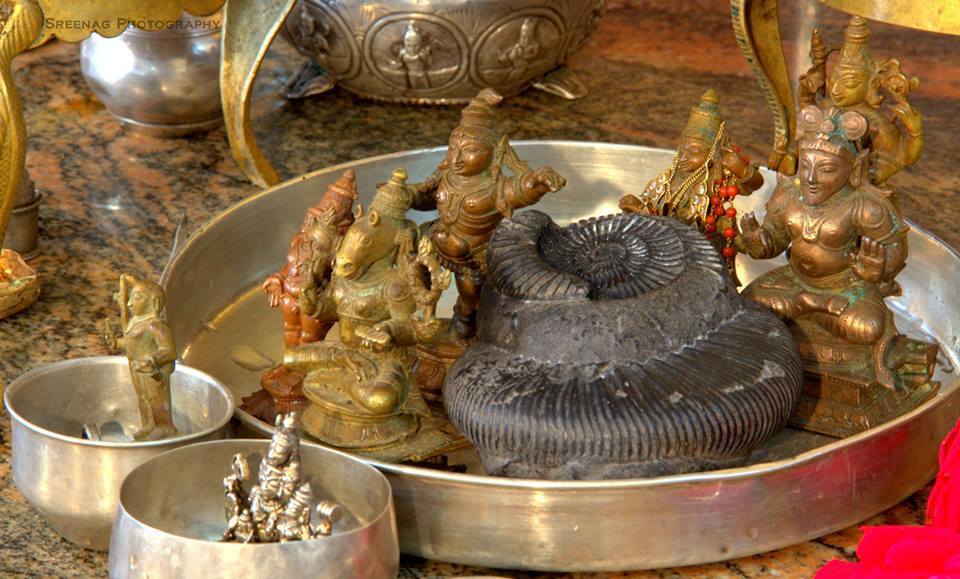
His Holiness Sri Sri 1008 Sri Vidyadheesha Theertha Swamiji of Palimaru
Matha.
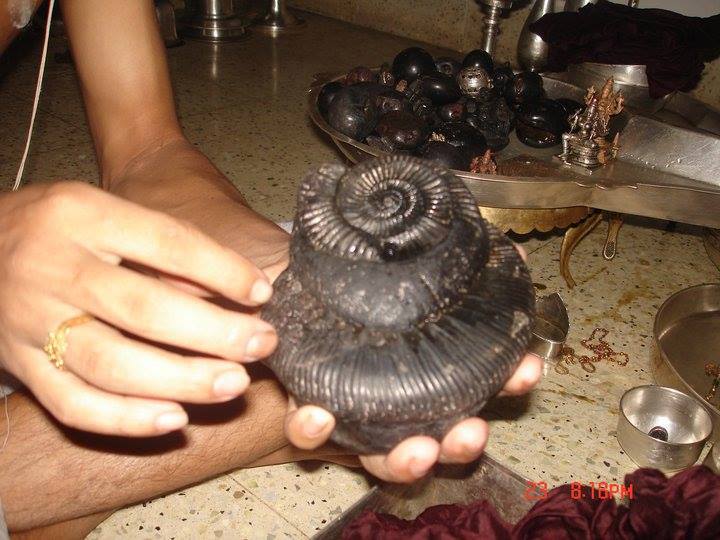
Shesha kunkdali also called Eka chakra Narayana Salagrama - Palimaru
Matha
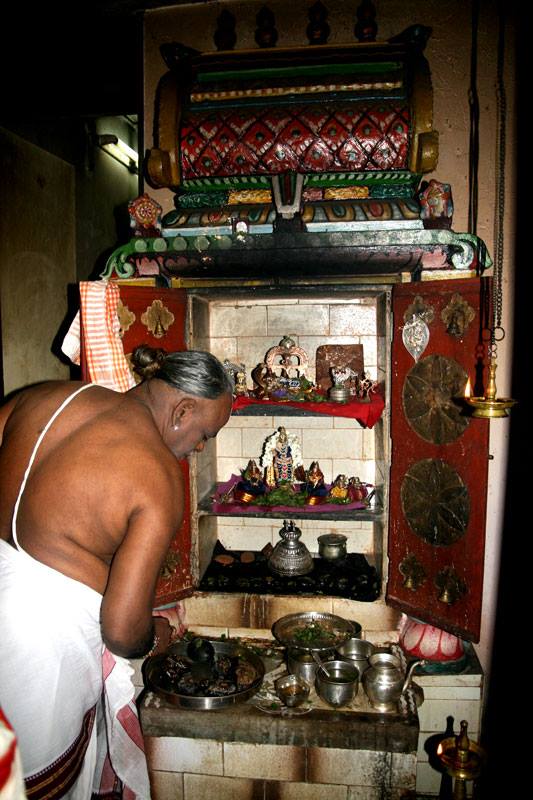
Very Old Salagrama Silas of Parasara Bhattar family in Srirangam
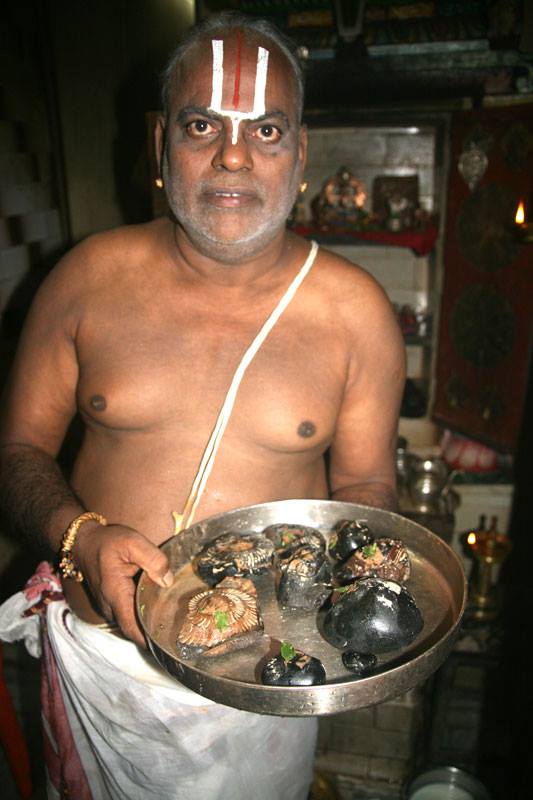
Very Old Salagrama Silas of Parasara Bhattar family in Srirangam
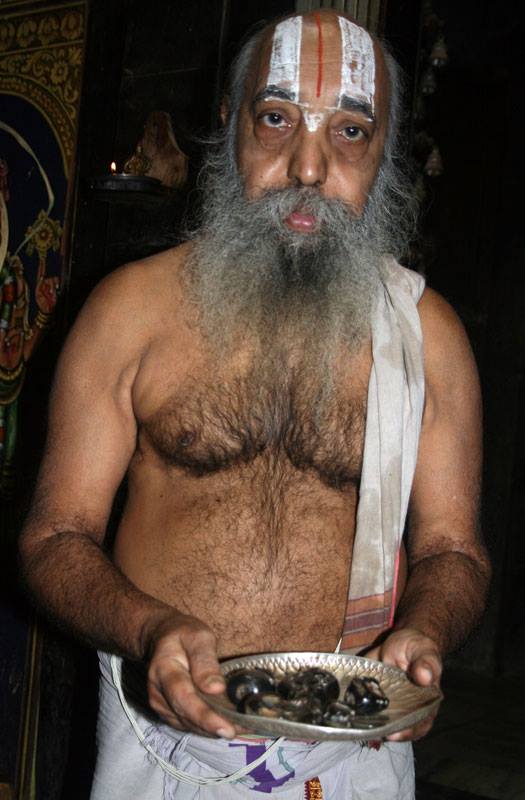
Salagramas of the Annan Kovil Temple in Sri Rangam
Here you see Annan Koil Swamy holding the beautiful Salagramas on a
silver plate. They are very unique, ancient and one can see how they are
polished
by the worship done by devotees over the last few hundred's centuries.
One of this Silas, is a carved like dancing Krishna. See for your self!
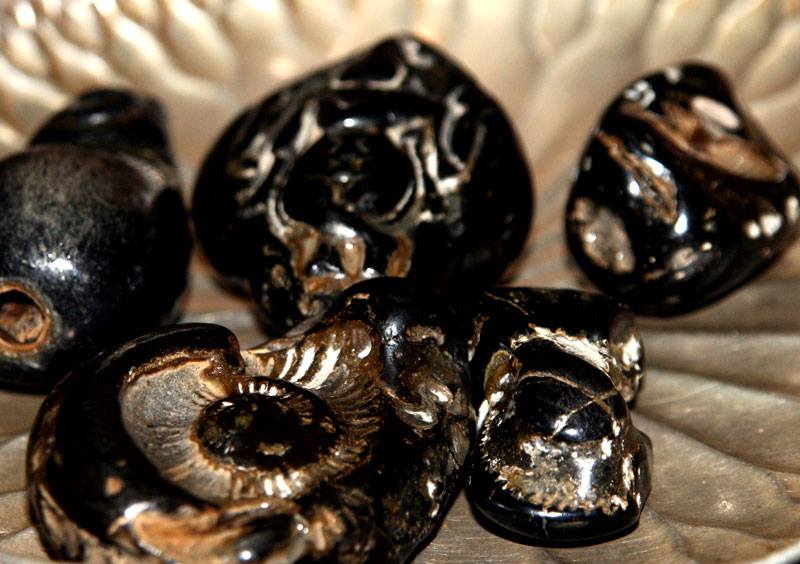
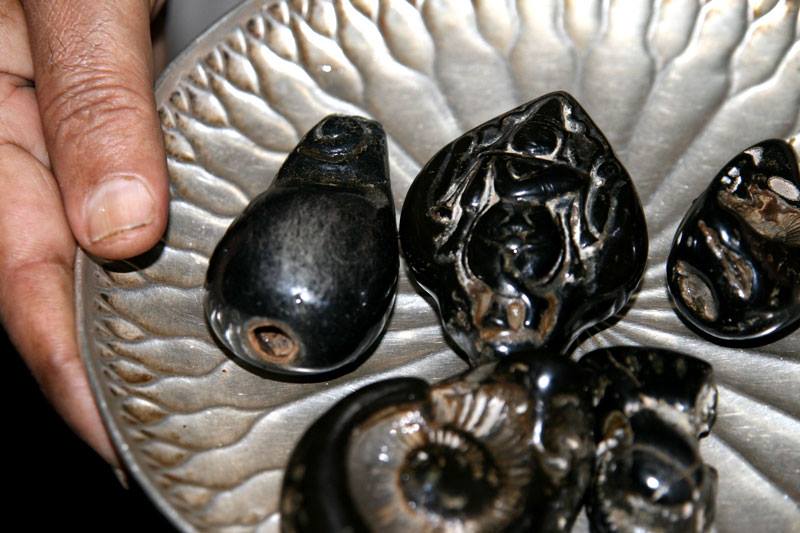
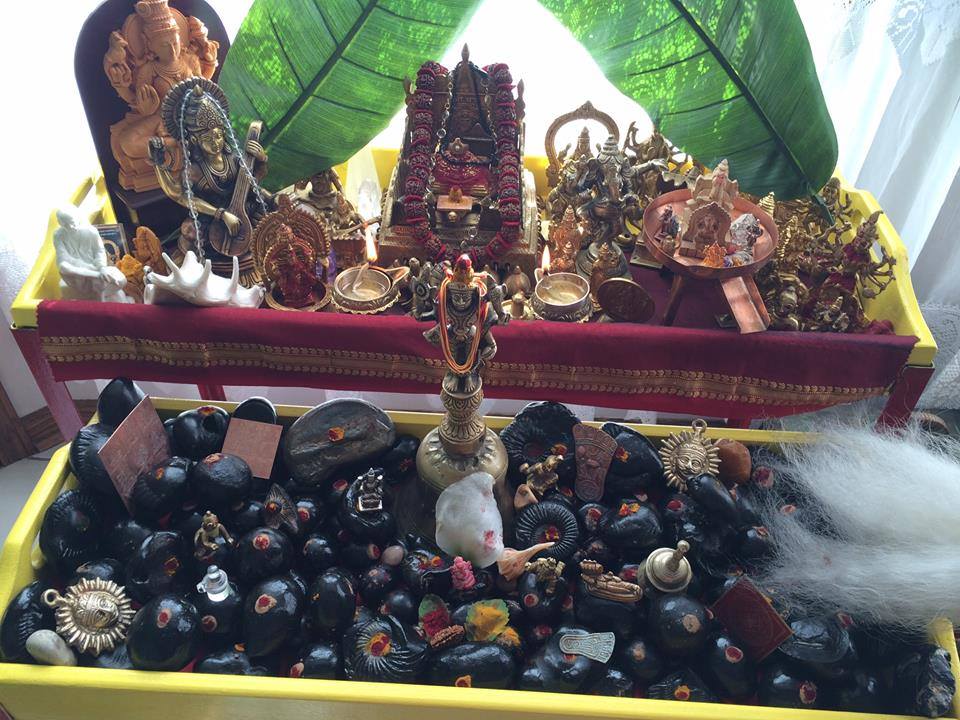
Divya Aloukika Salagrama Sannidhi

Photo courtesy from UTTARADIMATH & SRI SATYATMA TIRTHA SWAMIJI Info
& Activity Page
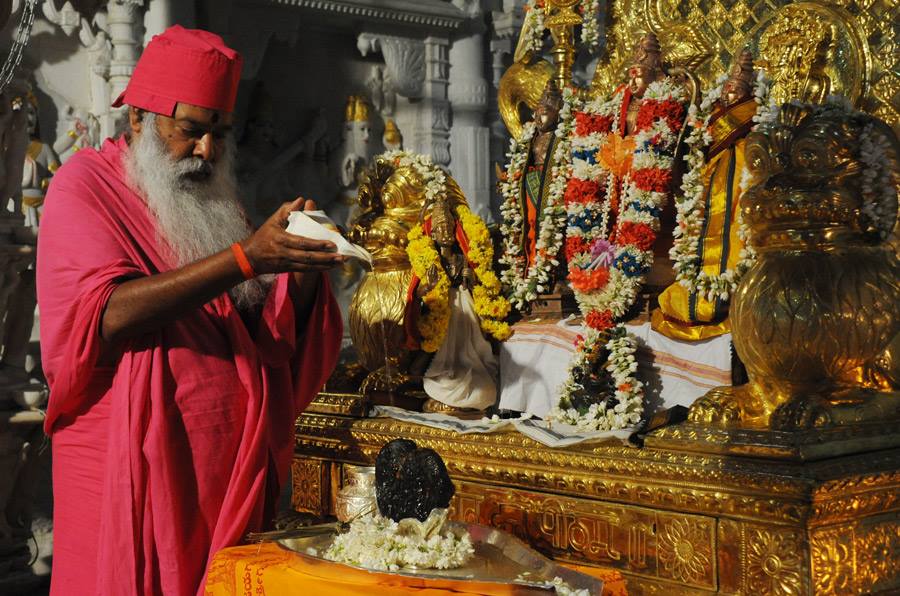
Abhisheka to "Rama Parivara Saligrama". This is a very rare spiritual
Saligrama stone where on one side Lord Rama, Sita, Lakshmana & Hanuman
have been delicately carved.
On the other side is the naturally formed pattern of Adi Shesha.
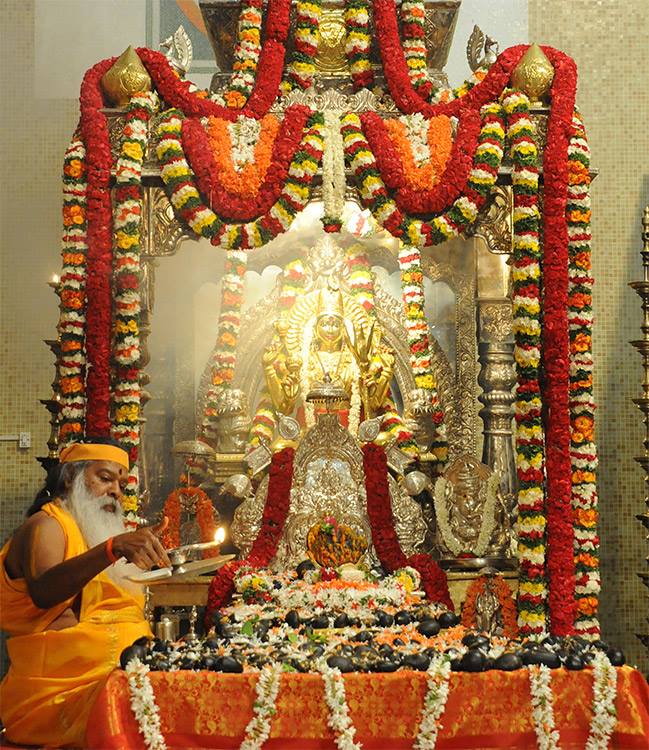
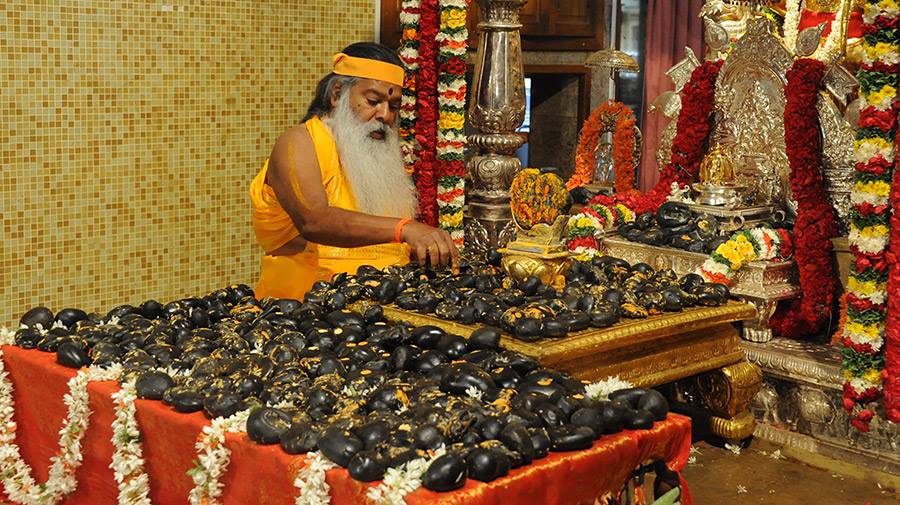
Salagrama Archana for Sri Rama Pattabhisheka Salagrama

Pujya Swamiji places Sri Rama Pattabhisheka Salagrama on Kurma Yantra
Peetham
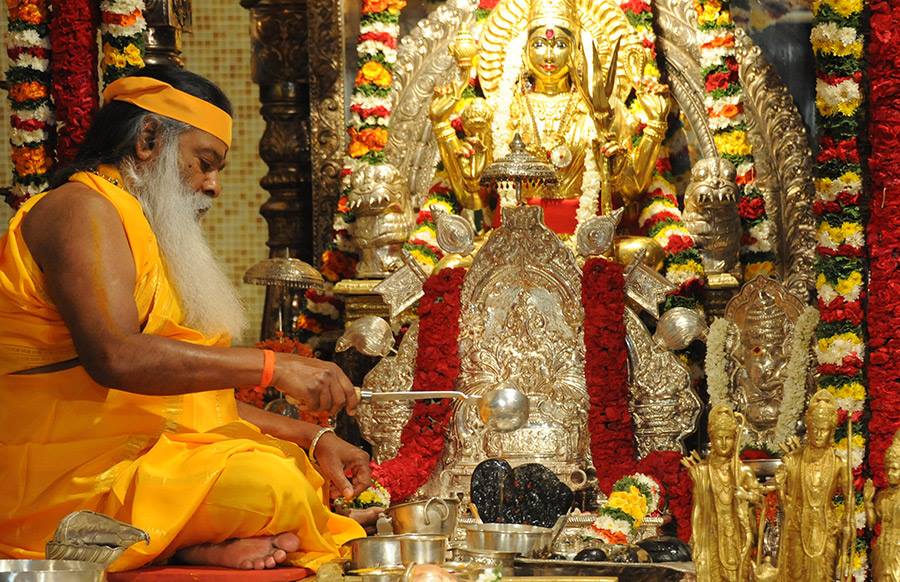
Abhisheka to Sri Rama Pattabhisheka Salagrama
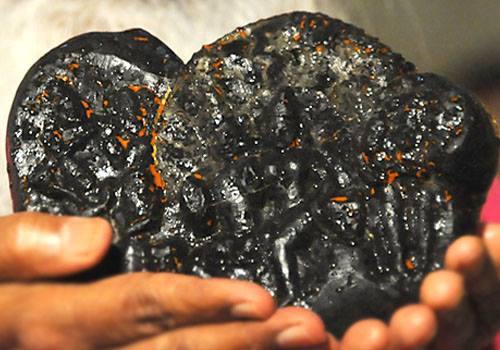
Rama Parivar on Salagrama sila ~ Dattapeetam
............and some perform this Panchayatana puja
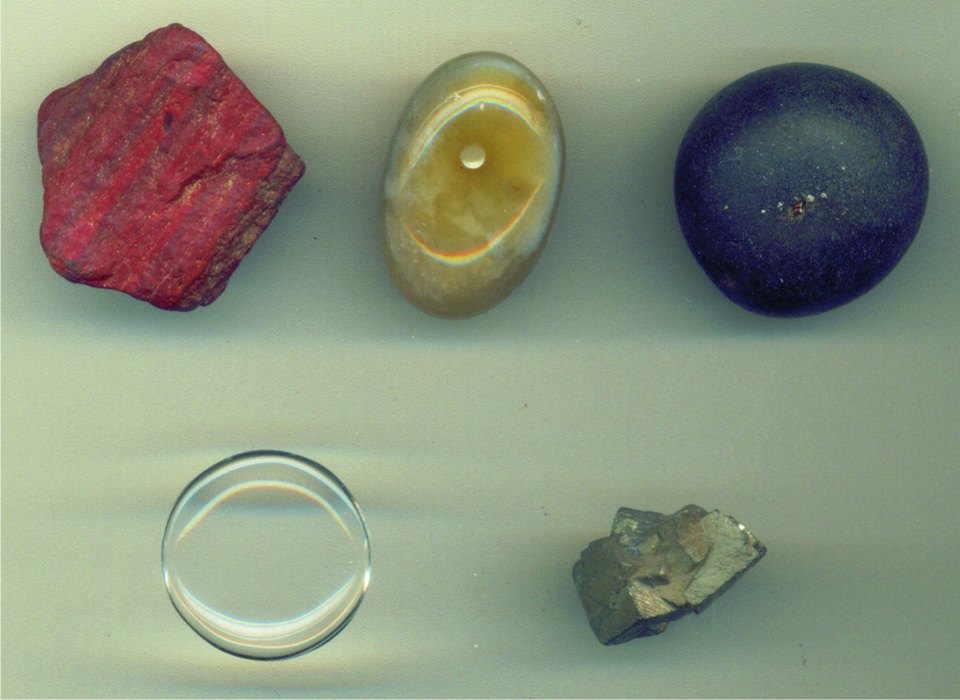
Panchayatana puja is the system of worship which was most common in
every house till few decades ago.
The Panchayatana is a system which consists of
the worship of five deities:
"Adityam Ambikaam Vishnum Gananaatam Maheswaram"
Aditya is Surya; Ambika is Devi; Vishnu is
Narayana; Gananaatham is Ganesha, Mahesvara is shiva.
These five are the great divine force whom every householder worships
as pancha devata puja.
Based on the tradition
followed by the family, one of these deities is kept in the center
and the other four surround it and worship is offered to all the deities.
Adhi Shankara systemetised the Sanatana Dharma(Hinduism) and classified
it into broad Six categories.
Shaiva - with Shiva as the Presiding deity
Vaishnava - with Vishnu as the Presiding deity
Shaktha - with Devi as the Presiding deity
Ganapatya - with Ganesha as the Presiding deity
Kaumara - with Subramanya as the Presiding deity
SoWra - with Surya (planets) as the Presiding deity
People mistake that Shri Shankara actually started this Panchayatana
puja system - which is wrong. Deva Puja and Archana is one of the most
important duties imposed by the Shastras. The Shastras are filled with
details of the Panchayatana puja details and Shankra only prescribed us
to follow it without fail..
The panchayatana scheme represent the five elements:
AkAshasyAdhipo viShNuH agneshchaiva maheshvarI |
vAyoH sUryaH kShiterIshaH jIvanasya gaNAdhipaH ||
Akasha : Space : Vishnu
Vahni : Fire : AmbikA
Vayu : Air : Aditya
kShiti : Earth : Shiva
Jala : Water : Ganapati
All the five deities are not Panchaloka or any other metal idols; But
these five are represented by small natural stones found in various parts
of Bharatha Desham.
Deity Stone River Place
Jala : Water Ganesha Red Sonabhadra Sone Bihar
Vayu : Air Surya Crystal Vallam Tamil Nadu (Tanjavur)
Akasha Space Vishnu Saligrama Gandaki Nepal
kShiti : Earth Shiva Bana Linga Narmada Madhya Pradesh
Vahni : Fire Ambika Swarna Mukhi Swarnamukhi Andra Pradesh
The image of that particular devata is kept in the centre, surrounded
by the other gods.
If he is a devotee of Vishnu, he places the idol of Vishnu in the centre
with the other idols surrounding it.
If he is a devotee of Lord shiva, a lingam is placed in the middle
with the other images around it. If he is a devotee of Suryanarayana, he
has a sphatika as the central object of worship.
The positioning in the panchayatana poojas are as follows:
Shiva Panchayatana Puja
Shiva at the center
Aditya at Southeast
Gananatha at Southwest
Ambika at Northwest and
Vishnu at the Northeast.
Ganapathy Panchayatana Puja
Ganapathy at the center
Vishnu at Northeast
shiva at Southeast
Adithya Southwest and
Ambal at Northwest
Vishnu Panchayatana Puja
Vishnu at center
shiva at Northeast
Ganapathy at Southeast
Adithya at Southwest and
Ambal at Northwest
Ambal Panchayatana Puja
Ambal at center,
Vishnu at Northeast,
shiva at Southeast,
Ganapathy at Southwest and
Adithya at Northwest
Adithya Panchayatana Puja
Adithya at center,
shiva at Northeast,
Ganapathy at Southeast,
Vishnu at Southwest,
Ambal at Northwest
Along with this people worshipping Subramanya will include Him in the
form of a (silver) Snake or Vel (spear)
shaiva ca vaiShNavam shaaktam sauram vainaayakam tathaa .
skaandam ca bhaktimaargasya darshanaani Shadeva hi ..
I can surely say - till panchayatana puja was strictly followed in our
country we were really flourishing. Though the technical advancements were
not present people were peaceful, satisfied and happy.
Only when this Panchayatana stopped during english invasion- we began
to loose our glory- happiness, mental peace and everything.
Panchayatana Puja is a systematic procedure which involves physical
and mental discipline, requires inner and outer cleanliness. This - when
done systematically will surely bring the progress in the material world
and the final truth - awareness of the true Self. By following it, one
obtains the Lord’s Anugraha, without
which liberation is not possible.
The Swarnamukhi ( Telugu:) is a river of southern India. It was mentioned
as Mogaleru in the works of Dhurjati.
The river flows near famous piligrimage Srikalahasti in Chittoor District
of Andhra Pradesh state, India.The Swarnamukhi river has five major Saivite
shrines along its course in the district. Besides Srikalahasti, there are
temples of Agastheswara in Thondavada, Parasareswara in Yogimallavaram,
Parasurameswara in Gudimallam and Moolasthaneswara in Gajulamandyam, to
which great religious significance is attached by the local people for
being on the bank of the equally-sacred river. It is not perennial and
flows in October to December of every year, and merges Bay of Bengal near
Tupilipalem. This age old Swarnamukhi River in Dhurjati’s time was known
as Mogaleru the river of Mogali Puvvulu.
The Son River (also spelt Sone) (Hindi:) of central India is the largest
of the Ganges' southern tributaries.
The Son originates near Amarkantak in Madhya Pradesh, just east of
the headwater of the Narmada River, and flows north-northwest through Madhya
Pradesh state before turning sharply eastward where it encounters the southwest-northeast-running
Kaimur Range. The Son parallels the Kaimur hills, flowing east-northeast
through Uttar Pradesh, Jharkhand and Bihar states to join the Ganges just
above Patna. Geologically, the lower valley of the Son is an extension
of the Narmada Valley, and the Kaimur Range an extension of the Vindhya
Range. Dehri on sone is the major town situated on Son River.
The Son river at 784 kilometres (487 mi) long, is one of the largest
rivers of India. Its chief tributaries are the Rihand and the North Koel.
The Son has a steep gradient (35–55 cm per km) with quick run-off and ephemeral
regimes, becoming a roaring river with the rain-waters in the catchmentarea
but turning quickly into a fordable stream. The Son, being wide and shallow,
leaves disconnected pools of water in the remaining part of the year. The
channel of the Son is very wide (about 5 km at Dehri on sone) but the floodplain
is narrow, only 3 to 5 km wide. In the past, the Son has been notorious
for changing course, as it is traceable from several old beds near its
east bank. In modern times this tendency has been checked with the anicut
at Dehri, and now more so with the Indrapuri Barrage.
Sir John Houlton, the British administrator, describes the Son as follows,
“After passing the steep escarpments of the Kaimur range, it flows straight
across the plain to the Ganges. For much of this distance it is over two
miles – and at one point, opposite Tilothu – three miles wide. In the dry
weather there is vast expanse of sand, with a stream not more than a hundred
yards wide, and the hot west winds pile up the sand on the east bank, making
natural embankments. After heavy rain in the hills even this wide bed cannot
carry the waters of the Son and disastrous floods in Shahabad, Gaya, and
Patna are not uncommon.”
The first obstruction in the Son was an anicut in 1873-74 at Dehri.
The Indrapuri Barrage was constructed, 8 km upstream, and commissioned
in 1968 The Bansagar Dam in Madhya Pradesh was commissioned in 2008.
The Son bridge built in deolond was inaugurated by Motilal Vora and
Pandit Ram Kishore Shukla then Chief Minister and Finance Minister of Madhya
Pradesh on 1986/02/13, the Koilwar Bridge, near Arrah, was amongst the
earlier long bridges in the country. It was opened in 1862. While the Koilwar
Bridge remained the longest bridge in the country, till it was over taken
by Nehru Setu, at Dehri, opened in 1900, the latter started off as the
longest bridge in the country, and retained its position as the longest
railway bridge for more than a century.
The Government of Bihar sanctioned in 2008, a bridge across the Son
River connecting Arwal and Sahar inBojpur district.
A four-lane road bridge, carrying NH 30, parallel to the existing rail
and road Koilwar Bridge, has been planned.
Famous Temples of India page
